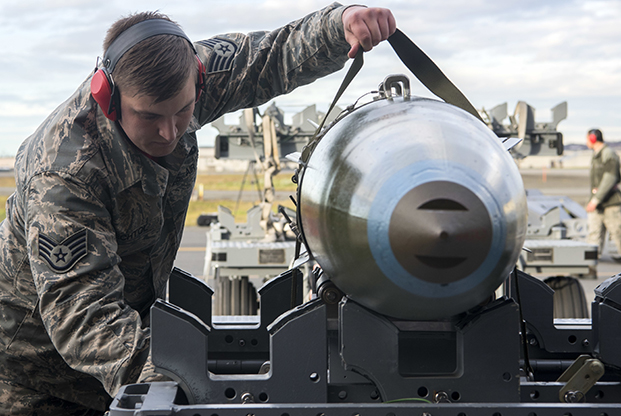
Air Force SSgt. Taylor Bechtol, a 90th Aircraft Maintenance Unit weapons load crew chief, loosens the straps on a GBU-32 Joint Direct Attack Munition during the quarterly load competition at JB Elmendorf-Richardson, Alaska, on Oct. 26, 2018. Air Force photo by A1C Jonathan Valdes Montijo.
Munitions contractors will be at maximum effort under the fiscal 2020 Air Force budget, rebuilding stockpiles whittled to perilously low levels by the conflict in Syria, and adding capacity against war reserve levels demanded by the National Defense Strategy.
The munitions spending plan “funds preferred munitions to industrial production capacity, emphasizing those munitions most relevant to the high-end fight,” the Air Force said in its budget overview documents. To “sustain air dominance and global precision attack capabilities,” USAF is stepping up buys not only of air-to-ground munitions but air-to-air missiles, as well.
The request doesn’t appear to have become budget “billpayers,” as Air Force acquisition chief Will Roper fretted they might last month. However, until the future years defense plan documents emerge next week, it’s not yet clear if the munitions buys will be sustained to achieve the most economic order quantities, or whether they soon will begin to once again porpoise in an up-and-down cycle that hurts efficiency and predictability for the bomb-makers.
Requested production of USAF munitions are funded in both the base budget and Overseas Contingency Operations funding, in order to allow a direct comparison from year to year, deputy budget director Carolyn Gleason said. Documents to be released next week will spell out the funding sources for each type, she said.
Gleason also said the fiscal 2020 munitions buy marks a “transition” to weapons needed for war against peer threats and away from those particularly suited for combat against violent extremists.
The request for the Joint Direct Attack Munition, or JDAM, is increasing from 36,000 units in fiscal 2019 to 37,000 in fiscal 2020. The Small Diameter Bomb would see a boost of about 20 percent, from 5,744 to 7,078. The AGM-114 Hellfire, used almost exclusively from MQ-9 remotely piloted aircraft, would tick up from 3,734 to 3,859 units. The Small Diameter Bomb II production rate would more than double, though, from 510 units in FY ’19 to 1,175 in FY ’20.
The AGM-158 Joint Air-to-Surface Standoff Missile-Extended Range, a stealth munition that can be carried on a variety of fighters and bombers, would see a significant increase from 360 units in ’19 to 430 in ‘20.
The AIM-9X Sidewinder heat-seeking dogfight missile would increase from 256 in ’19 to 355 in ’20, while the AIM-120D AMRAAM radar-guided dogfight missile would increase from 187 units to 220.